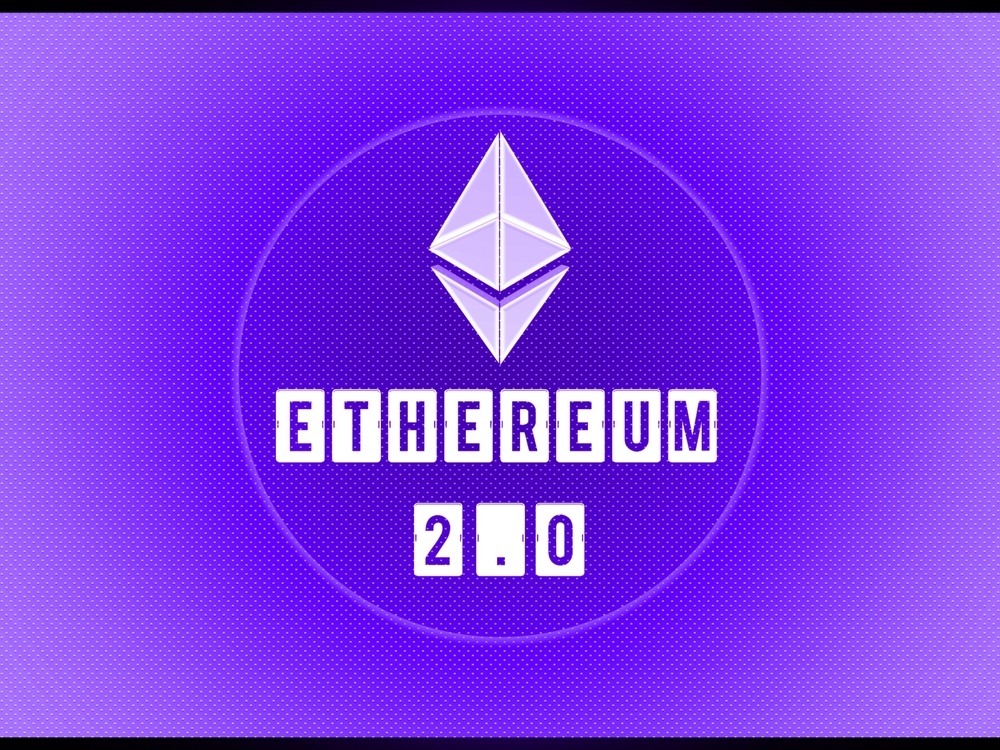Ethereum’s “Merge” and What it Means for The Future of Crypto

Ethereum (ETH) is by far one of the largest blockchain networks within the crypto sphere and has managed to revolutionize it through the addition of programmable smart contracts, which have been utilized as a means of disrupting traditional financial services.
In fact, due to its smart contracts functionality and “gas” implementation for the fees, Ethereum has become the home for a lot of decentralized applications (dApps), which have paved the way for Decentralized Finance (DeFi).
It also contributed to the development, minting, and growth in popularity surrounding non-fungible tokens (NFTs).
However, while Ethereum does provide even the unbanked, or in other words, people without an ID or without access to financial services, access to them, it has been utilizing a consensus mechanism known as Proof-of-Work (PoW), which is not eco-friendly and aims to move to the Proof-of-Stake (PoS) consensus mechanism through an upgrade known as “The Merge.”
As such, today, we are going to go over just about everything that you need to know when it comes to this upgrade and how it can shape the future of crypto.
The Current State of Ethereum

The Current State of Ethereum
Before we go over the Merge, or Ethereum 2,0, we need to go over exactly why this was a process that took so much time to get developed and what kind of issues Ethereum has been facing.
Specifically, whenever a transaction occurs and needs to be executed on top of the Ethereum blockchain, users are required to pay gas fees.
These gas fees are typically payments that are made by users as a means of compensating for the energy, which is required to validate the transactions that occur on top of the Ethereum (ETH) blockchain network.
Specifically, the default version of Ethereum that we utilize today requires miners to contribute their computing power as a means of solving cryptographic puzzles, after which they can verify transactions on the network. What this means is that every single miner on this network has to be incentivized to do this kind of work somehow, and this is in the form of a gas fee.
Understanding Ethereum’s Consensus Mechanism

Understanding Ethereum’s Consensus Mechanism
When we take a look at any blockchain network that is created similarly to Ethereum, which is a distributed database, the network nodes, which are the computers running the software, have to reach an agreement on the state of the network. This is an agreement that gets achieved through the utilization of what is known as a consensus mechanism.
Furthermore, while these consensus mechanisms are not linked directly to building a decentralized application (dApp), it is important to fully understand them to understand why Ethereum’s upgrade is important.
Consensus relates to a general agreement being reached. What you need to do is consider a group of people that might host a game night. If there is no disagreement when it comes to which game is played, this means that this group of people has managed to reach some form of consensus.
Now, when we take a look at this from the perspective of the blockchain, this process is formalized. The way consensus is reached where at least 51% of the full nodes within the network can agree on the next global state of the network.
Consensus Mechanism: Explained

Consensus Mechanism Explained
A consensus mechanism, which is also referred to as a consensus protocol, allows distributed systems, which is a network of computers, to essentially work together as a means of staying as secure as possible.
Consensus protocols, as well as algorithms, are used interchangeably. However, they are different in some cases.
The consensus protocol is a set of rules that are defined within a standard that is responsible for governing how a system and its functioning parts can operate and even interact. Alongside this, algorithms are like blueprints on how to solve a specific issue or how to calculate area results.
These mechanisms have been utilized as a means of establishing a consensus across database nodes and even application servers or enterprise infrastructure uses. However, in the past decade or so, these have been utilized in blockchain technology and cryptocurrency systems, such as Ethereum, to agree on the state of the overall network.
The consensus mechanism can be viewed as this economic system, which can aid in the prevention of specific kinds of economic attacks. If an attacker could control 51% or more of the network, they could compromise it. However, this is unfeasible. There have also been different mechanisms engineered to solve security issues in numerous ways.
Ethereum, by default, and in its current state prior to “The Merge” occurring, which is scheduled in September of 2022, utilizes the Proof-of-Work (PoW) consensus mechanism.
What this does is essentially allow the nodes of the network to agree on the specific state of all of the information that is recorded on top of it and can prevent specific kinds of economic attacks from taking place on top of the network.
Proof-of-Work (PoW) as a consensus mechanism will be phased out in favor of the alternative, eco-friendlier consensus mechanism known as Proof-of-Stake (PoS), but before we dive into that, we need to fully go over and understand how PoW works.
Blocks Explained

Blocks Explained
Blocks within a blockchain are essentially batches of transactions that have a hash of the previous block within the chain.
This can link blocks together, forming a chain, due to the fact that the hashes are cryptographically derived from the data block. What this results in is fraud prevention due to the fact that one change in any block in the history would make all of the following blocks invalid, and all subsequent hashes would change, which everyone running the blockchain would notice.
As a means of ensuring that all of the participants within the Ethereum network can maintain a synchronized state and agree on the specific price history of the transactions, transactions get batched into blocks. Here, hundreds of transactions are committed, agreed upon, and even synchronized all at once.
Through spacing out these commits, Ethereum can give all network participants enough time to come to a consensus, and even though translation requests can occur hundreds of times per second, the blocks within the Ethereum network are committed approximately once every 15 seconds.
Now, as a means of preserving the transaction history within the network, blocks are ordered, where every new block that gets created on top of the network contains a reference to its parent block, and the transactions that are within these blocks are also ordered.
Aside from rare cases, at any given time, all of the participants within the network are in agreement on the exact number and history of blocks and are even working on batching the current live transaction requests within the next blocks.
Once a block has been completed, or in other words, mined, by a miner within the network, it is then propagated to the rest of the overall network. Furthermore, all of the nodes can then add this block to the end of their blockchain, after which the mining can continue/
The exact block-assembly, or mining process, and even the commitment or consensus process are specified through the Proof-of-Work (PoW) protocol.
It is also important to understand what actually forms a block.
Each block that gets added to the Ethereum blockchain includes the following data:
- timestamp – this is essentially the time when the block was mined, or more specifically, information surrounding that fact.
- blockNumber – this is a reference to the length of the blockchain in terms of overall blocks.
- baseFeePerGas – this is a direct reference to the minimum fee per gas that is required for a transaction to get included within the block.
- difficulty – this refers to the effort which is required to mine a block.
- mixHash – this refers to a unique identifier for every specific block in the network.
- parentHash –this is essentially a unique identifier for the block which came before the new one, and this is the way through which blocks are linked within a chain.
- transactions – this refers to data surrounding transactions that are included within the block.
- stateRoot –this is a reference to the entire state of the system and includes account balances, contract storage, contract code, as well as account nonces that are inside.
- nonce – this refers to a hash that, when combined with the mixHash, can prove that the block has undergone the Proof-of-Work (PoW) process.
With that out of the way, we can move on to block time, as well as the block size.
Block time within the sphere of a blockchain is a reference to the time it takes to mine a new block.
The average length of time for this process to occur on top of the Ethereum blockchain prior to the Merge is between 12 to 14 seconds, which is evaluated after each block. The expected block time is a set of a constant and the protocol level, which is used to protect the network’s security at a point in time when the miners add more computational power.
Furthermore, the average block time gets compared with the expected block time, and if the average block time is higher, in that case, the difficulty is decreased within the block header. However, if the average block time is smaller, it increases.
However, when we take a look at block size, each block has a target size of 15 million gas. However, the size of the block can increase or decrease in accordance with the network demands until a block limit of 30 million gas, which is twice the target block size.
This means that the total amount of gas that is expended by all of the transactions within the block has to be less than the block gas limit, and this is important as it can ensure that the blocks cannot be arbitrarily large. If blocks can be arbitrarily large, however, then less performant full nodes can gradually stop being able to keep up with the network, as a result of the space as well as the speed requirements due to this.
Proof-of-Work Explained

Proof-of-Work Explained
We have discussed the Proof-of-Work (PoW) consensus mechanism numerous times now; however, to truly understand how it works, we need to look at it in a much higher level of detail. Proof-of-Work (PoW) is the mechanism that lets Ethereum come to a consensus or to an agreement on the account balances and the order of the overall transaction, which in turn prevents someone from “double spending,” or spending the same amount of crypto twice, which can ensure that the Ethereum blockchain can be difficult to attack or manipulate in any way as-well.
PoW is the underlying algorithm that is responsible for the process of setting the difficulty alongside the rules for the work that miners need to do. Mining, in this case, is the work, and it is the act of adding valid blocks within the chain.
This plays an important role due to the fact that the length of the chain can help the network follow the correct Ethereum chain and have a high level of understanding when it comes to its state. The more work gets done through mining, the longer the chain becomes, and as such, the higher the block number ends up becoming.
Mining is the process of creating a block of transactions that gets added to a previous block that already exists on the chain, and this is why it is called a blockchain. The first block to ever get mined is known as the “genesis block.” When miners mine the Ether (ETH) cryptocurrency, they are essentially securing the network.
Ethereum miners are computers that run their software and use their time as well as computational power to process the transactions and produce blocks.
In decentralized networks such as the Ethereum network, the network needs to ensure that everyone can agree on the order of transactions. Miners can help this happen through the process of solving computationally difficult puzzles and producing blocks, where in turn, they secure the network from attacks.
There are numerous costs associated with mining Ethereum (ETH); for example, one cost is the purchase of and maintenance of the mining rigs. Furthermore, there are electrical costs associated with mining, and if a person that miners cryptocurrencies enter a mining pool, they will typically charge a flat percentage fee on each block that gets generated by the pool.
There are also costs involved with the maintenance of the equipment, such as the ventilation, electrical wiring, and so on.
When we look at the mining process a bit more in-depth, a user can essentially write and sign a transaction request with a private key that they have in their account.
Then, this user would broadcast the transaction request to the entire Ethereum network from a node.
Once the network hears about the transaction request, each node will add the request to a local mempool, which is a list of all of the transaction requests that they know about and have heard about and have not yet been committed to the blockchain in the form of a block.
Here, the mining node is given the opportunity to essentially aggregate several dozen or hundreds of transaction requests within a potential block, and this occurs in a way that maximizes the transaction fees that they earn whilst still staying under the block gas limit.
Here, the mining node verifies the validity of the transaction request and then executes the code of the request, where the state of their local copy of the Ethereum Virtual Machine (EVM) is altered. The miner awards the transaction fee for the transaction request to their account.
Then, a process begins of producing the PoW certificate of legitimacy for the block in question once all of the transaction requests in the block have been verified and executed on the local EVM copy.
At the point in time when a miner finishes producing the certificate, which includes the specific transaction request, the miner can then broadcast the completed block, which can also include the certificate and the checksum of the new EVM state.
Other nodes can then hear about the new block, and they can verify the certificate and execute all of the transactions on the block themselves, whilst also verifying that the checksum of their new EVM state after the transaction, of all of the transactions, actually matches the checksum of the state that is claimed by the block of the miner.
It is only at this point in time that nodes can append this block to the tail of the blockchain and accept it in the chronological state. Here, each node can then remove all of the transactions in the new block from their local mempool of unfulfilled transaction requests.
New nodes that end up deciding to join the network will have to download all of the blocks in sequence, and this includes the block containing the transaction of interest,
They can also initialize a local EVM copy and then execute every transaction in every block on top of the local EVM copy, through which they would verify the state checksum at each block along the way,
This way, every transaction is mined and included in a new block and propagated for the first time once; however, executed and verified by every participant in the process of advancing the canonical EVM state.
Here, each of the blocks has a block difficulty, a mixHash, and a nonce. The block data is directly related to PoW.
Ethereum’s Proof-of-Work (PoW) protocol is known as Ethash, and it requires miners to go through the process of an intense race, which includes trial and error, as a means of finding the nonce for a specific block. Only blocks that have a valid nonce can then be added onto the chain.
However, when they are racing towards creating a block, a miner will repeatedly put a database that they can only get through the process of downloading and running the full chain through a mathematical function, after which the dataset gets used to generate a mixHash under the target nonce directed y the block difficulty.
Here, the miners are incentivized to do the work on top of the Ethereum chain. The objective of this consensus mechanism is to extend the chain, as the longest chain is believable as the valid one due to the fact that it had the most computational work done to it.
Due to Ethereum’s PoW implementation, it is almost impossible to create new blocks which erase transactions, create fake ones, or even maintain a second chain due to the fact that a malicious miner would need to always solve the block nonce much quicker than anyone else.
Furthermore, through this PoW consensus mechanism, the new currency gets added to the system and incentivizes the miners to do work. In other words, miners that successfully create a block get rewarded with Ether (ETH) coins. However, they do not receive all of the transaction fees, as the base fee gets burned, while the tip and block reward goes to the miner.
Proof-of-Work (PoW) has, however, been criticized due to the fact that it uses a lot of electricity and requires a lot of energy output as a means of ensuring that the network remains safe. This is why Ethereum is going through The Merge as a means of ensuring that the network can be a lot eco-friendlier, alongside numerous other benefits that come with the transaction to Proof-of-Stake (PoS).
Gas Explained
Gas refers to a unit that is responsible for the process of measuring the amount of computational effort that is required to execute operations on top of the Ethereum network.
Due to the fact that Ethereum transactions require computational power to get executed, every transaction has a fee associated with it, and the gas is a reference to the fee that is required to complete a transaction successfully on top of the network.
Each of these gas fees is paid out in Ethereum’s native cryptocurrency, known as Ether (ETH), where the gas prices are denominated in “gwei.” Gwei is a denomination of ETH, where each gwei is equal to 0.000000001 ETH (10-9 ETH).
This means that if a transaction costs 0.000000001 ETH, you could say that the transaction has a cost associated with it of 1 gwei.
Proof-of-Stake (PoS): Everything You Need to Know

Proof-of-Stake (PoS) Everything You Need to Know
The Ethereum network requires a lot of computational power to stay secure, and when the network is congested, this results in high gas fees. The network is expensive to develop and used for a variety of different decentralized finance (DeFi) use cases.
This is why there are numerous Layer-2 solutions developed on top of Ethereum, some of which even use Proof-of-Stake (PoS) already, that aim to decrease the costs associated with using Ethereum.
However, “The Merge,” otherwise known as Ethereum 2.0 or ETH2, aims to change the Proof-of-Work (PoW) consensus mechanism to a Proof-of-Stake (PoS) consensus mechanism instead, directly on the Layer-1 network.
PoS switches out the importance of computational power for staked Ether (ETH), and PoS replaces the miners with validators. Validators here can stake their ETH as a means of getting the ability to create new blocks.
The validators do not compete to create new blocks; instead, they are chosen at random through the utilization of an algorithm.
At certain points in time, also known as checkpoints, if ⅔ of the validators end up agreeing on the state of the block, it is considered to be final at that point in time. Validators have to bet their entire stake on this, so if they try to collude, they will end up losing their entire stake.
Why This Merge Is So Important
The current version of the Ethereum Mainnet will merge with the Beacon Chain, which features the Proof-of-Stake (PoS) system, which is currently set to occur in September of 2022, but the date is not official.
This is an important upgrade to the overall network due to the fact that it will mark the end of the Proof-of-Work (PoW) consensus mechanism on , where the network will experience a full transition into PoS.
This sets the scene when it comes to future scaling upgrades, such as sharding for example. The Merge will also reduce Etheruem’s energy consumption by 99.95%.
All of this means that THe Merge is the most important and significant upgrade in the history of the blockchain, and extensive testing, as well as bug bounties, were implemented as a means of ensuring a safe transition into PoS.
The Merge Explained
The Merge is a representation of Ethereum’s transition to the new Proof-of-Stake (PoS) consensus layer, which eliminates any requirement for energy-intensive mining, and, instead, can secure the network through the usage of staked Ether (ETH). This will ultimately lead to a higher level of scalability, security, and even sustainability.
The Beacon Chain of Ethereum was separate from the Mainnet. The Mainnet features all of the accounts, balances, smart contracts, and blockchain state, while the Beacon Chain runs in parallel and utilizes Proof-of-Stake (PoS) already. The Merge is the process of these two systems coming together.
Ethereum’s journey began in 2015, and throughout its history, there have been numerous developers preparing for an eventual transition away from the PoW consensus mechanism.
On December 1, 2020, the Beacon Chain ended up getting created, which has since existed in a separate blockchain when compared to the mainnet, which runs in parallel.
The Beacon Chain did not process mainnet transactions but reached a consensus on its own state through agreeing on the active validators and their account balances.
How Ethereum Will Impact the Crypto Space

How Ethereum Will Impact the Crypto Space
Within Ethereum, mining will no longer be a requirement when it comes to the production of valid blocks. Instead, the Proof-of-Stake (PoS) validators will have to assume this role and will have the responsibility of processing the validity of all of the transactions and the block proposals.
Furthermore, no history will be lost; as when the mainnet merges with the Beacon Chain, it will also merge the entire transactional history of Ethereum.
After The Merge ends up completing, we will see the end of Proof-of-Work (PoW) as it is on Ethereum, and we will enter a new era of blockchains, ones that are a lot more sustainable, a lot eco-friendlier, and a lot more appealing as a result of this.
This will also result in much higher scalability upgrades to be possible, which were not possible under the Proof-of-Work (PoW) consensus mechanism, which brings Ethereum a step closer to achieving full-scale security and scalability.
In the original plans which were outlined for Ethereum, sharding was meant to be implemented prior to The Merge as a means of addressing scalability. However, due to the rapid increase in popularity and appeal surrounding Layer-2 scaling solutions, the priority shifted towards swapping Proof-of-Work (PoW) to Proof-of-Stake (PoS) through The Merge.
Plans for sharding are evolving on a rapid basis; however, due to the success of the Layer-2 technologies to scale transaction execution, they were shifted to finding the most optimal way to distribute the process of storing compressed calldata from rollup contracts, which would, in turn, allow for a much higher level of exponential growth in the network’s overall scalability, which will not be possible without the transaction to PoS.
The final phase, which is expected to happen, later on, is known as “The Shard Chains,” which will help scale the Ethereum network due to the fact that it will bring the following developments. Instead of settling all of the operations within a single network, the shard chains can spread the operation across a total of 64 chains.
Furthermore, this will make it a lot easier to run an Ethereum node and will require less powerful hardware for this to be available. Due to this, Ethereum could theoretically be able to process up to 100,000 transactions per second (TPS), leading to a much higher level of utility and scalability of the blockchain.
What this Means for Proof-of-Work (PoW) Miners
Proof-of-Stake (PoS) will eliminate any requirement for expensive equipment as well as electricity, which makes it a lot easier for the average user to participate in the overall staking and validation process.
The environmental toll that the PoW governance system uses has historically been the main point of criticism and concerns regarding cryptocurrencies, and with PoS, this will decrease by 99.95%.
What this means is that there will be fewer requirements for people to buy mining rigs and contribute a lot of time towards maintaining them whilst also using a lot of electricity to mine the Ether (ETH) cryptocurrency through racing to complete a block in the blockchain.
What this means is that miners will likely need to look for alternative coins to mine now for older projects that utilize Proof-of-Work (PoW) as their main consensus mechanism.
However, this also means that a lot of miners will have a lot of mining equipment available, which cannot be utilized for Ethereum anymore, which means that they might need to sell the equipment in question, assuming the profit margins from mining are not the same, or at least close to the ones seen whilst mining Ether (ETH).
The Future of Blockchains

The Future of Blockchains
Based on all of this, it is highly likely that any new blockchains that get developed from the ground up will likely use the Proof-of-Stake (PoS) consensus mechanism by default.
Furthermore, Ethereum has been the home to a lot of Layer-2 solutions built on top of it, which means that each of the new networks that decide to get built on top of Ethereum can also take advantage of the increased scalability and utility of the network after the switch.
There have been numerous blockchains created that utilize Proof-of-Stake (PoS) at Layer-1 even prior to Ethereum’s switch and merge; however, this Merge will prove that even an existing blockchain that uses PoW can switch to PoS efficiently.
If this does indeed manage to occur successfully, we might see other blockchains potentially making this switch due to the variety of different benefits that are gained as a result of this.
It is clear that the development team behind Ethereum is pushing a lot of developments on top of the network and are making their way towards a future where the network can be maintained a lot more efficiently, require a lot less power, and will not need to require miners to buy the most expensive hardware out there in order to secure the network, all of which will contribute to its sustainability long-term.
It is likely that a lot of developers of decentralized applications (dApps) will likely jump on board and start developing for the Ethereum network as a means of taking advantage of this heightened level of scalability, utility, and energy efficiency and bring their ideas to life, which will lead to an increase in the demand, and utility of the Ether (ETH) cryptocurrency.
The future will tell how successful this Merge will end up being, but based on all of the tests and test networks thus far, it is likely that it will contribute towards a healthy level of growth to the broader ecosystem.
